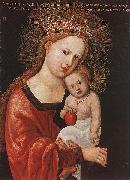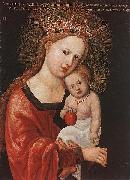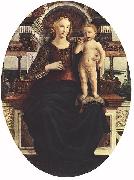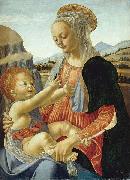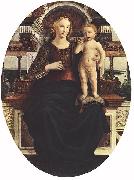Wholesale Oil Painting Reproductions No Minimum and Door to Door! |
|||||||||||
|
|
|||||||||||

|
|||||||||||
|
|
|
||||||||
All Albrecht Altdorfer Oil Paintings |
||||||||
|
|
||||||||
|
|
||||||||
|
Artist Introduction: German
1480-1538
Albrecht Altdorfer Galleries
He most often painted religious scenes, but is mainly famous as the first frequent painter of pure landscape, and also compositions dominated by their landscape. Taking and developing the landscape style of Lucas Cranach the Elder, he shows the hilly landscape of the Danube valley with thick forests of drooping and crumbling firs and larches hung with moss, and often dramatic colouring from a rising or setting sun. His Landscape with footbridge (National Gallery, London) of 1518-20 is claimed to be the first pure landscape in oil. He also made many fine finished drawings, mostly landscapes, in pen and watercolour. His best religious scenes are intense, sometimes verging on the expressionistic, and often depict moments of intimacy between Christ and his mother, or others. His most famous religious artwork is the The Legend of St. Sebastian and the Passion of Christ that decorated the altar in the St. Florian monastery in Linz, Austria. He often distorts perspective to subtle effect. His donor figures are often painted completely out of scale with the main scene, as in paintings of the previous centuries. He also painted some portraits; overall his painted oeuvre was not large. |
||||||||
|
|
||||||||
|
Mary with the Child Painting ID:: 76657 |
between 1520(1520) and 1525(1525)
wood
35.5 cm (14 in). Height: 49.4 cm (19.4 in).
cjr |
|||||||
Height Width |
INS/CM Quality |
|||||||
|
X |
| |||||||
|
|
||||||||
All Albrecht Altdorfer Oil Paintings |
||||||||
|
|
||||||||
|
|
||||||||
|
Artist Introduction: German
1480-1538
Albrecht Altdorfer Galleries
He most often painted religious scenes, but is mainly famous as the first frequent painter of pure landscape, and also compositions dominated by their landscape. Taking and developing the landscape style of Lucas Cranach the Elder, he shows the hilly landscape of the Danube valley with thick forests of drooping and crumbling firs and larches hung with moss, and often dramatic colouring from a rising or setting sun. His Landscape with footbridge (National Gallery, London) of 1518-20 is claimed to be the first pure landscape in oil. He also made many fine finished drawings, mostly landscapes, in pen and watercolour. His best religious scenes are intense, sometimes verging on the expressionistic, and often depict moments of intimacy between Christ and his mother, or others. His most famous religious artwork is the The Legend of St. Sebastian and the Passion of Christ that decorated the altar in the St. Florian monastery in Linz, Austria. He often distorts perspective to subtle effect. His donor figures are often painted completely out of scale with the main scene, as in paintings of the previous centuries. He also painted some portraits; overall his painted oeuvre was not large. |
||||||||
|
|
||||||||
|
Mary with the Child Painting ID:: 78438 |
between 1520(1520) and 1525(1525)
Medium wood
Dimensions Width: 35.5 cm (14 in). Height: 49.4 cm (19.4 in).
cyf |
|||||||
Height Width |
INS/CM Quality |
|||||||
|
X |
| |||||||
|
|
||||||||
All Piero Pollaiuolo Oil Paintings |
||||||||
|
|
||||||||
|
|
||||||||
|
Artist Introduction: (c. 1443 - 1496), also known as Piero Benci, was an Italian Renaissance painter from Florence. His brother was the artist Antonio del Pollaiolo and the two frequently worked together. Their work shows both classical influences and an interest in human anatomy; reportedly, the brothers carried out dissections to improve their knowledge of the subject.
He died in Rome in 1496.
|
||||||||
|
|
||||||||
|
Mary with the Child Painting ID:: 85894 |
Date between 1470(1470) and 1473(1473)
Medium tempera and Oil on canvas
Dimensions Height: 73 cm (28.7 in). Width: 54 cm (21.3 in). (oval)
cjr |
|||||||
Height Width |
INS/CM Quality |
|||||||
|
X |
| |||||||
|
|
||||||||
All Andrea del Verrocchio Oil Paintings |
||||||||
|
|
||||||||
|
|
||||||||
|
Artist Introduction: Italian Early Renaissance Sculptor, ca.1435-1488
Florentine sculptor and painter, whose real name was Andrea di Michele di Francesco di Cioni. He was a leading figure in the early Renaissance, and his workshop was a center for the training of young artists in Florence. A virtuoso metalworker, Verrocchio was primarily concerned with the spirited rendering of movement and the elaboration of detail. Many of his paintings are lost. Of the remaining panels, his hand is evident in the Baptism of Christ (Uffizi), assisted by Leonardo da Vinci. In the Pistoia altarpiece he was aided by Lorenzo di Credi. Other attributions are Tobias and the Angel (National Gall., London), two paintings of the Madonna and Child (National Gall., London; Berlin), and a Crucifixion with Saints (Argiano). Most of Verrocchio's achievements in sculpture have survived. His earlier work includes the bold group Incredulity of St. Thomas (Orsanmichele). In 1472 he designed the tombs of Piero and Giovanni de' Medici (San Lorenzo). In the same period he created the graceful Boy with a Dolphin and a lithe portrayal of David (Bargello). He went to Venice (c.1480) to work on the equestrian monument of the condottiere Bartolomeo Colleoni. |
||||||||
|
|
||||||||
|
Mary with the Child Painting ID:: 86814 |
Date 15th cent.
Medium Oil on poplar
Dimensions Height: 67.3 cm (26.5 in). Width: 49.4 cm (19.4 in).
cjr |
|||||||
Height Width |
INS/CM Quality |
|||||||
|
X |
| |||||||
|
|
||||||||
All Piero Pollaiuolo Oil Paintings |
||||||||
|
|
||||||||
|
|
||||||||
|
Artist Introduction: (c. 1443 - 1496), also known as Piero Benci, was an Italian Renaissance painter from Florence. His brother was the artist Antonio del Pollaiolo and the two frequently worked together. Their work shows both classical influences and an interest in human anatomy; reportedly, the brothers carried out dissections to improve their knowledge of the subject.
He died in Rome in 1496.
|
||||||||
|
|
||||||||
|
Mary with the Child Painting ID:: 90047 |
between 1470(1470) and 1473(1473)
Medium tempera and oil on canvas
Dimensions Height: 73 cm (28.7 in). Width: 54 cm (21.3 in). (oval)
cyf |
|||||||
Height Width |
INS/CM Quality |
|||||||
|
X |
| |||||||
|
|
||||||||
|
Prev Next
|
||||||||
|
|
||||||||
|
Related Paintings to Piero Pollaiuolo :. |
||||||||
|
|
||||||||
|
CONTACT US |
